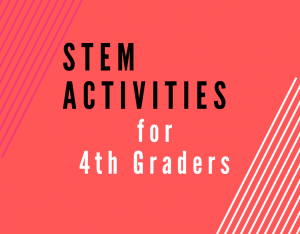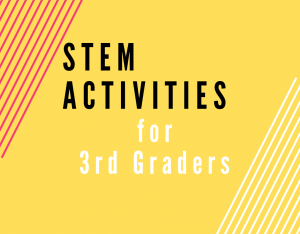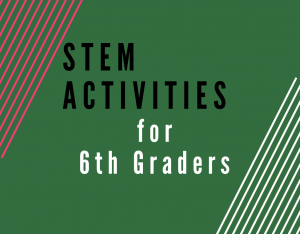If you’re looking for STEM activities for first graders, you’ve come to the right place. Research has shown that early childhood is the best time to be introduced to STEM. But, if you’ve just learned about the importance of STEM, it’s better late than never. First grade is when math and science classes get introduced, so when STEM is added into the curriculum, it can be powerful. When STEM concepts are integrated at this level, STEM skills are built while existing concepts are reinforced.
STEM education is an interdisciplinary approach to teaching science, technology, engineering, and math. STEM activities for first graders often combine subjects because of their nature. As students progress through grades, STEM activities will still include multiple disciplines but with higher levels of difficulty. This approach prepares them for a future STEM careers.
As a librarian given the task of facilitating STEM programs for the local community, I have spent countless hours researching what STEM is and what activities are the most effective while also being in line with its philosophy. What most online sources don’t understand is that STEM is interdisciplinary and meant to be integrated into the classroom to teach real-world concepts through hands-on experiments. I am lucky to have found the book Teaching STEM in the Early Years by Sally Moomaw, which truly portrays this through its many great activities. I have had success using the following activities from the book because they are all fascinating!
Table of Contents
Fossil Creation
Materials
- self-hardening clay
- playdough rollers
- seashells
Description
The examination of fossils reveal that many contain the imprint of ancient shells or shells that have turned to stone. In this activity, children will use self-hardening clay to create their fossils. First, playdough rollers are used to smooth the clay. Next, students create an imprint by pressing seashells into the clay. The dried clay will resemble the imprints produced in stone over millions of years. Students may also trim the clay into squares before it dries to form clay tiles.
Seashells can be purchased at craft stores inexpensively. After the tiles have hardened, children can examine them again and try to find the shells that fit into them. This reinforces the idea that fossils preserve the form of the original object or creature.
STEM Content
- Science
- Fossils are stones made from preserved remains or impressions of plants or animals that died millions of years ago. They form when sediment covers the remains of an organism after it dies. In some cases, mineral-rich groundwater fills small cavities in the plant or animal and hardens into stone over time. In other cases, a mold is left behind from the remains of the wholly dissolved organism.
- Math
- The designs of many seashells are symmetrical. Scallops shells show bilateral symmetry; each side is a mirror image of the other. Often appearing in nature are shells with a spiral design that forms a particular type of pattern known as “Fibonacci sequence.” This activity aligns with geometry through the shapes and symmetry of the shells.
- Geometric transformations are made as first graders turn, slide, and flip shells trying to fit them into their hardened molds. A shape is rotated a certain number of degrees with a turn. In a slide, the repositioning moves all points on the shape as a unit. A flip shows the reflection of an object.
STEM Connections
- Technology and Engineering
- Technology and engineering methods are used by paleontologists to remove and preserve fossils. The book Digging Up Dinosaurs by Aliki shows this process well for first graders.
What To Say and Ask
- Would you like to press the shell into the clay and see what the imprint looks like?
- Here is the clay tile you made earlier this week. Can you find the shells that fit into the molds on your tile? Isn’t it like a puzzle?
- The ridges from the shell are in your clay mold. Can you see them?
- Does the starfish fit precisely into the mold when you turn it?
Shapes In Nature
Materials
- geometrically shaped natural objects (see description)
- plastic containers for sorting
- geometric forms in nature photographs
- informational books that show shapes in nature
Description
This activity gives first graders the chance to identify geometric shapes found in nature and to group objects based on this characteristic.
First, show them books that reveal shapes in nature. Shapes in Nature, the wordless concept book by Judy Feldman and Star in My Orange: Looking for Nature’s Shapes by Dana Meachen Rau are good examples that can lead to discussions. Next, lay out the plastic containers with signs labeling and showing geometric shapes. Finally, lay out natural objects and ask students to sort them into the containers.
Circular or spherical objects in this activity are a sand dollar, a sea urchin, a buckeye, a small bird’s nest, and a sweet gum pod. Oval objects include pumpkin seed, a leaf from a jade plant, an avocado seed, a cowrie seashell, a pumpkin seed, and a plastic bird’s egg. Objects that are triangular or conical are a naturally chipped rock, a feather, a pinecone, a small replica of a spruce tree, and a fern (preserved in self-laminating film). Pentagons include a locust pod, a starfish, a dried apple slice showing the core, a flower (preserved in self-laminating film), and a sand dollar (the shape inside is a pentagon). Hexagons include a flower, a large leaf, a wasp comb, and a plastic snowflake replica.
STEM Content
- Science
- Squares and rectangles are not represented in this activity because they are not prevalent in nature. This is an interesting topic to discuss with children. Extremely common in organic objects (matter from organisms that are living or were once living) are pentagonal objects. While hexagonal shapes are less common in natural substances, they are prevalent at the molecular level in inorganic materials. However, hexagons do appear in flower petal arrangements and on the shells of some species of turtle.
- Math
- This activity focuses on geometry and helps children identify various representations of shapes. For example, the feather is not the standard equilateral triangle that children usually see in toys. Instead, it is thin and long. Seeing shapes in several different configurations helps children focus on the defining attributes of each shape. Counting is reinforced as children count how many sides each shape has, especially when they try to distinguish between pentagons and hexagons.
What To Say and Ask
- Can anyone find something with a circular shape to go in this box?
- Can you explain why you put the sand dollar in the pentagon box? Sarah says it’s round.
- How can we tell whether this wasp comb should go with the hexagons or pentagons?
Clusters of Bubbles
Materials
- Several bowls
- Dish-washing liquid
- Water
- Straws
- Digital camera
Description
Children blow air through a straw into a bowl containing a small amount of soapy water to form clusters of bubbles. At first, children may be interested in the size of the bubble clusters they can produce. But, once that initial excitement wears off, they can be directed to look at the geometric shapes created by the interlocking bubbles.
Children also like popping bubbles. Bubbles quickly pop if a dry finger is inserted into them; but, if children moisten a finger by first dipping it into some bubble solution, the finger can go through the bubbles without popping. Children are also fascinated by the bubbles’ colors and reflections.
The only things that are needed to make the bubble solution is a bowl containing a small amount of water and a squirt of liquid dish-washing soap added to it. Spills can be absorbed by placing towels underneath the bowls. To prevent children from sucking up soapy water, poke a hole near the top of the straw using a safety pin. Students will still be able to blow air through the straw while not being able to suck up the liquid.
STEM Content
- Science
- Because they are blowing air into the water through their straws, children are likely to conclude that air is filling the inside of the bubbles. A film that encases the bubble is formed from the water because of its surface tension. The soap strengthens the weakest parts of the bubble, keeping it intact longer.
- Light reflects from both the outer and inner surfaces, which produces its colors. The change in colors is a result of the various thicknesses of the bubble film, combined with the multiple reflected wavelengths causing interference.
- Math
- A significant component of bubble experiments is geometry. A bubble spherical because a sphere is the minimum area needed to enclose a given volume. Bubbles in a cluster interconnect to produce many domed hexagonal shapes. Children may also find triangular and rectangular forms.
STEM Connections
- Technology and Engineering
- The bubbles usually do not last long, making observation time-limited. Taking digital photographs of the first graders’ bubble clusters preserve the bubble cluster images, allowing students as much time as needed to count the sides of the shapes.
What To Say and Ask
- What happens when air is blown into the soapy water?
- I’m going to take photographs of some of the bubble clusters. This will give us more time to count the shapes made by the bubbles. Then we can make a bubble shape chart.
- As I look at the bubbles from different angles, the colors seem to change. They are iridescent.
- Use a dry finger to touch a bubble. What happened? Now, try again using a soapy finger by dipping it in this bowl of bubble solution. What happened this time?
Shadow Tracing
Materials
- Sidewalk chalk
- Digital camera (optional)
Description
Shadows can be very deceiving, which may be why children find them so fascinating. Shadows change in position and size. Sometimes they are on a wall, and sometimes they appear on the ground. One moment a shadow can seem to be following someone around, and the next moment it disappears. This fun STEM activity for first graders helps young students acquire a context for when and where shadows occur and learn what factors affect their appearance.
This activity should take place outside on a sunny day and when it is not too close to 12 o’clock. Children can work in pairs. While one child stands still, another child traces their partner’s shadow using sidewalk chalk. Students can take turns tracing shadows for their partners and posing for shadows.
The children’s names and times the shadows were traced should be written inside the outlines so that they can return to them at different times during the day and compare their current shadow to the shadow outline that was traced previously.
STEM Content
- Science
- A shadow is an area that is blocked by a light source. The image of the shadow is a reverse projection of the object that is blocking the light. So, if a child who is creating a shadow moves his right leg, the shadow will appear to lift its left leg. The shadow’s length is created by the sun, increasing as the angle between the sun and the earth decreases. Because of this, shadows are long early in the morning, decrease in length until noon, and then continually increases until they are long again before sunset.
- Math
- The math content in this activity relates to measurement. Children compare the length of their shadows at different times during the day to the size of the drawn outline.
STEM Connections
- Technology
- Digital photographs of children tracing the shadows of their peers may be taken. When the shadows are either larger or smaller than the lines, the photos may help children establish that the shadow was initially within the chalk lines.
What To Say and Ask
- Do you notice anything about the change in the size of your shadow? Is it different from when your friend outlined it this morning?
- Remember not to look directly at the sun but glance up at it. Do you notice where the sun is now compared to before?
- What do you think will happen if we retrace shadows tomorrow?
- Watch what happens to my shadow when I stand here. Part of it is on the ground, and part of it is on the wall.
Ants All Over
Materials
- 4 small plastic containers lids
- small amounts of sugar, cheese, crackers, and water
- note cards
- labels for the materials, placed in each lid
- digital camera (optional)
Description
Whether you live in an urban, suburban, or rural area, ants are part of most people’s environments. Children notice ants and their often uncoordinated movements on the sidewalk, in the grass, and on plants. This activity helps first graders learn about the materials that attract ants.
Children can help put small amounts of each type of food in the shallow lids and label accordingly. Some good choices are sugar (sweet), cheese (protein), and crackers (carbohydrate) because they represent different types of food. The fourth dish can be filled with water. Dishes should be kept in a spot where they will not be stepped on or disturbed.
At different times throughout the day, children can check on the dishes to count how many ants are in each. These observations can then be discussed. Digital photographs can be taken so each observation can be shown during discussion. After counting the ants, children can put the foods in order based on the number of ants that were on each food lid.
STEM Content
- Science
- One way scientists learn about organisms is through observation. In this activity, children conduct an experiment and make observations because they have added specific items into the environment of the ants. Children may see ants carrying relatively large pieces of food. Ants can lift objects that weigh twenty times their weight.
- Before or after the activity, you may want to teach a little more about ants than they know from observing them. A great book to show them is Ants by Melissa Stewart because it includes vivid photographs and has the appropriate amount of text for first graders.
- Math
- The counting of the ants on the various food trays is critical to this activity because the investigation focuses on which foods ants like best. Some children may make a visual comparison, while other children may attempt to count the ants. Regardless of strategy, this experience supports the development of number sense. When the foods are ordered based on the number of ants on the lids, children work within the mathematical area of data analysis.
STEM Connections
- Technology
- Digital photography preserves the children’s observations. It also makes it easier to count the ants in the photographs. Most modern digital cameras also record the date and time of each photograph in the metadata, enabling the precise time of the observation to be preserved.
What To Say and Ask
- Check out all the ants that came to eat. Which food lid has the most ants on it? Which has the fewest?
- We have eight observations of our ants to see, let’s make a chart showing how many ants are on each food lid for each observation.
- Now let’s put the foods in order based on how many ants were attracted. Did the same food have the most ants every time an observation was made?
Source
Moomaw, Sally. Teaching STEM in the Early Years: Activities for Integrating Science, Technology, Engineering, and Mathematics. Redleaf Press, 2013.



